Hydrologic Response Unit Routing in SWAT to Simulate Effects of Vegetated Filter Strip for South-Korean Conditions Based on VFSMOD
Abstract
:1. Introduction
2. Materials and Methods
2.1. Limitations of the SWAT for VFS and Diversion Channel Simulation
2.1.1. Limitation of SWAT for Flow and Sediment Routing in Overland Flow
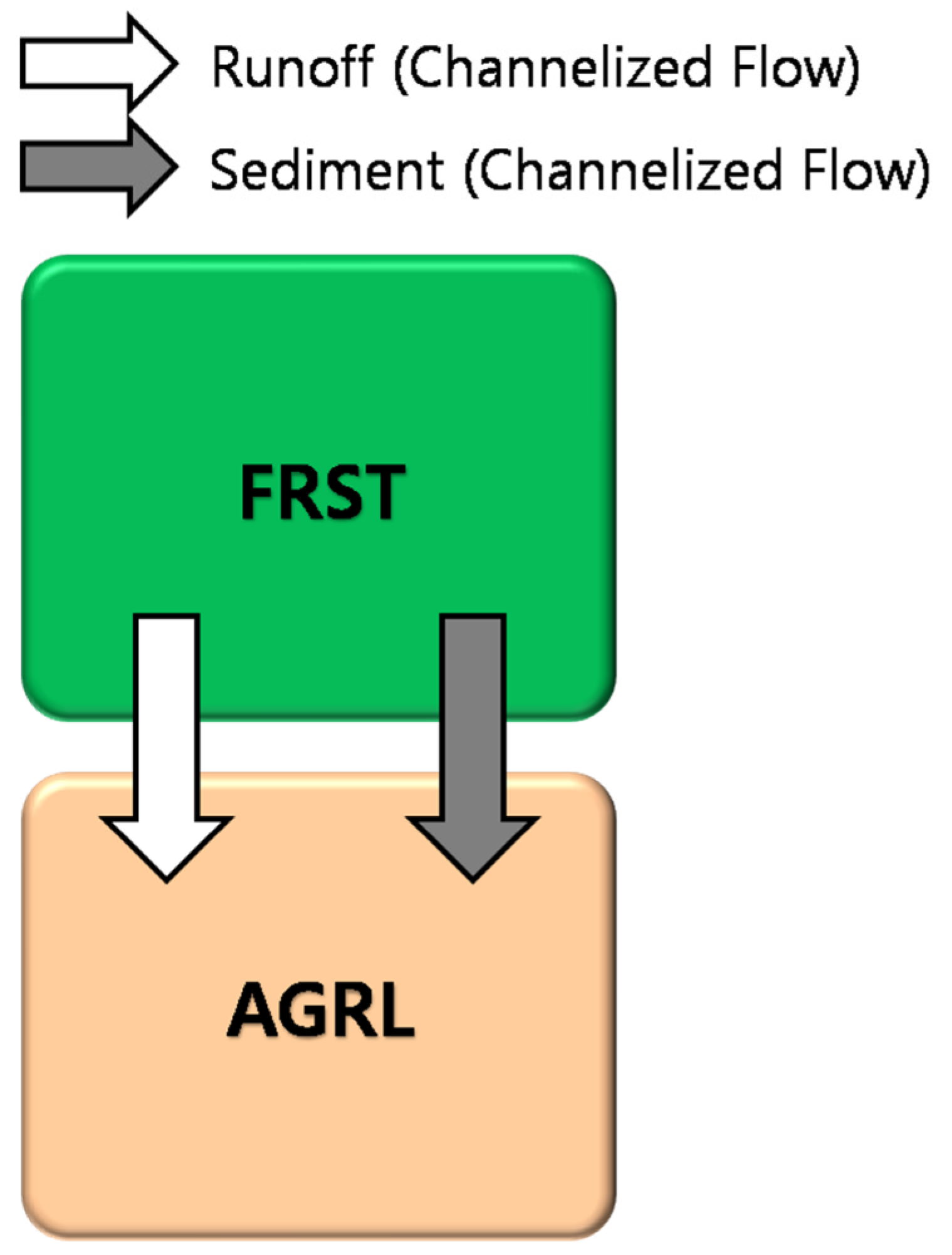
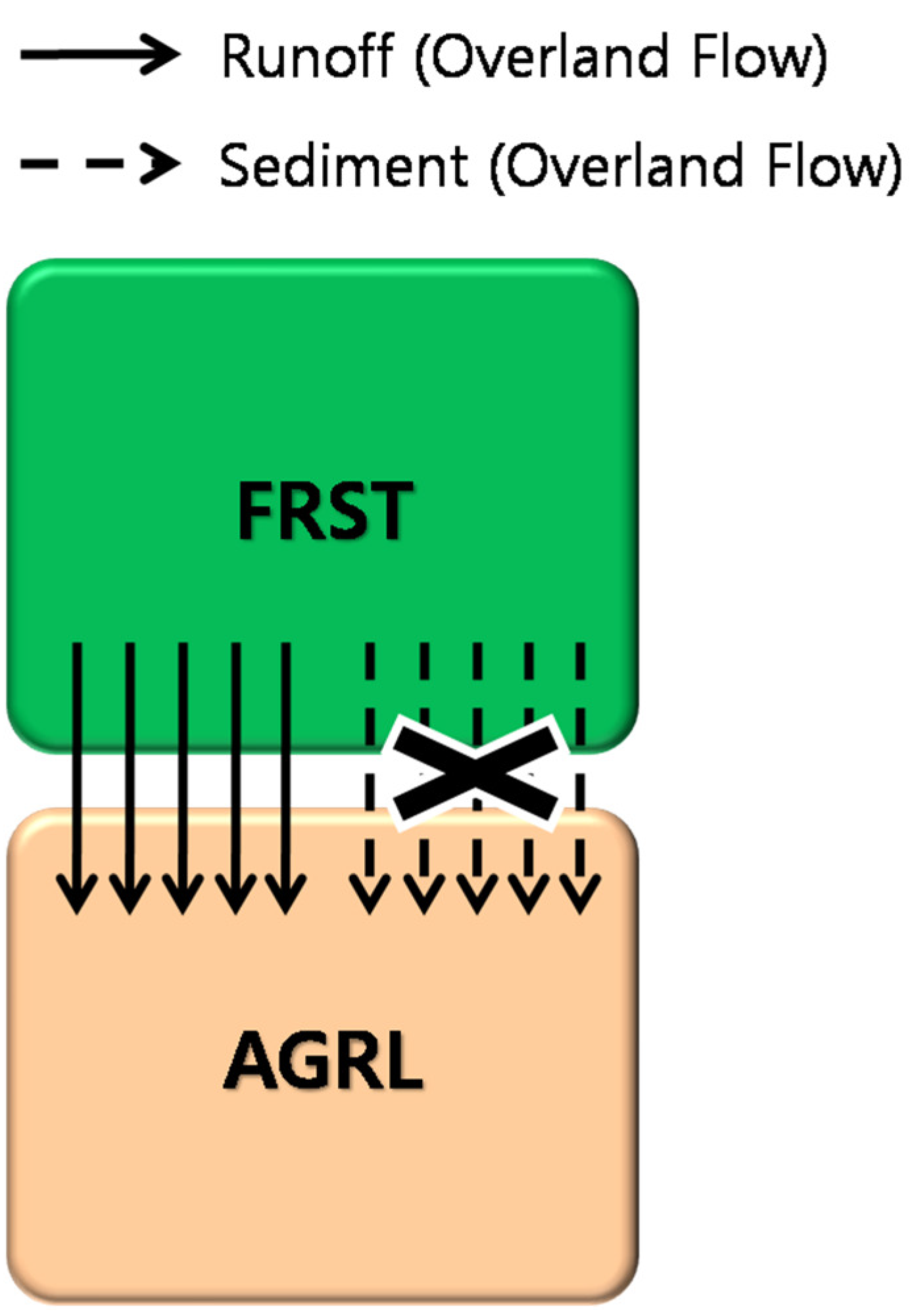
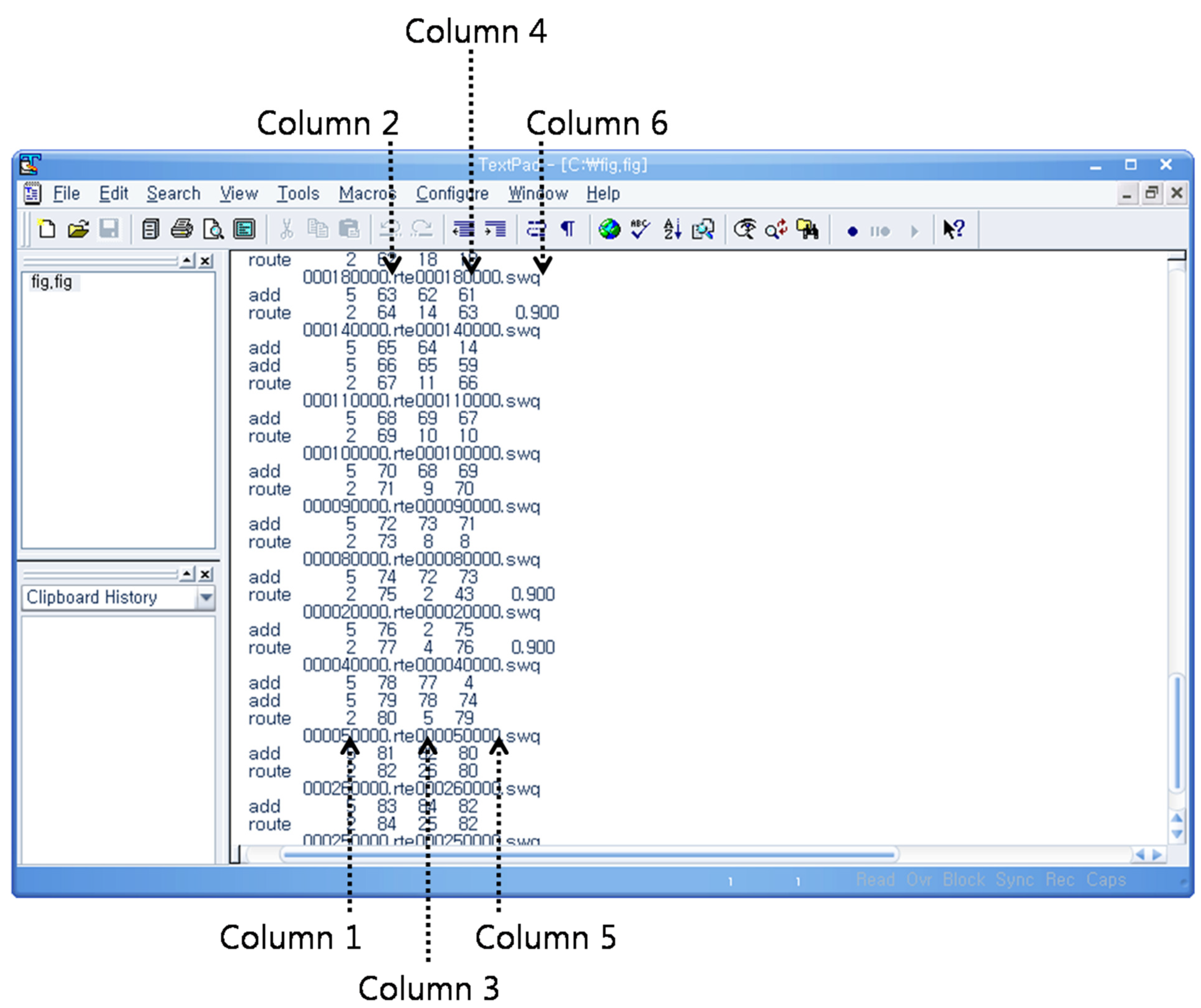
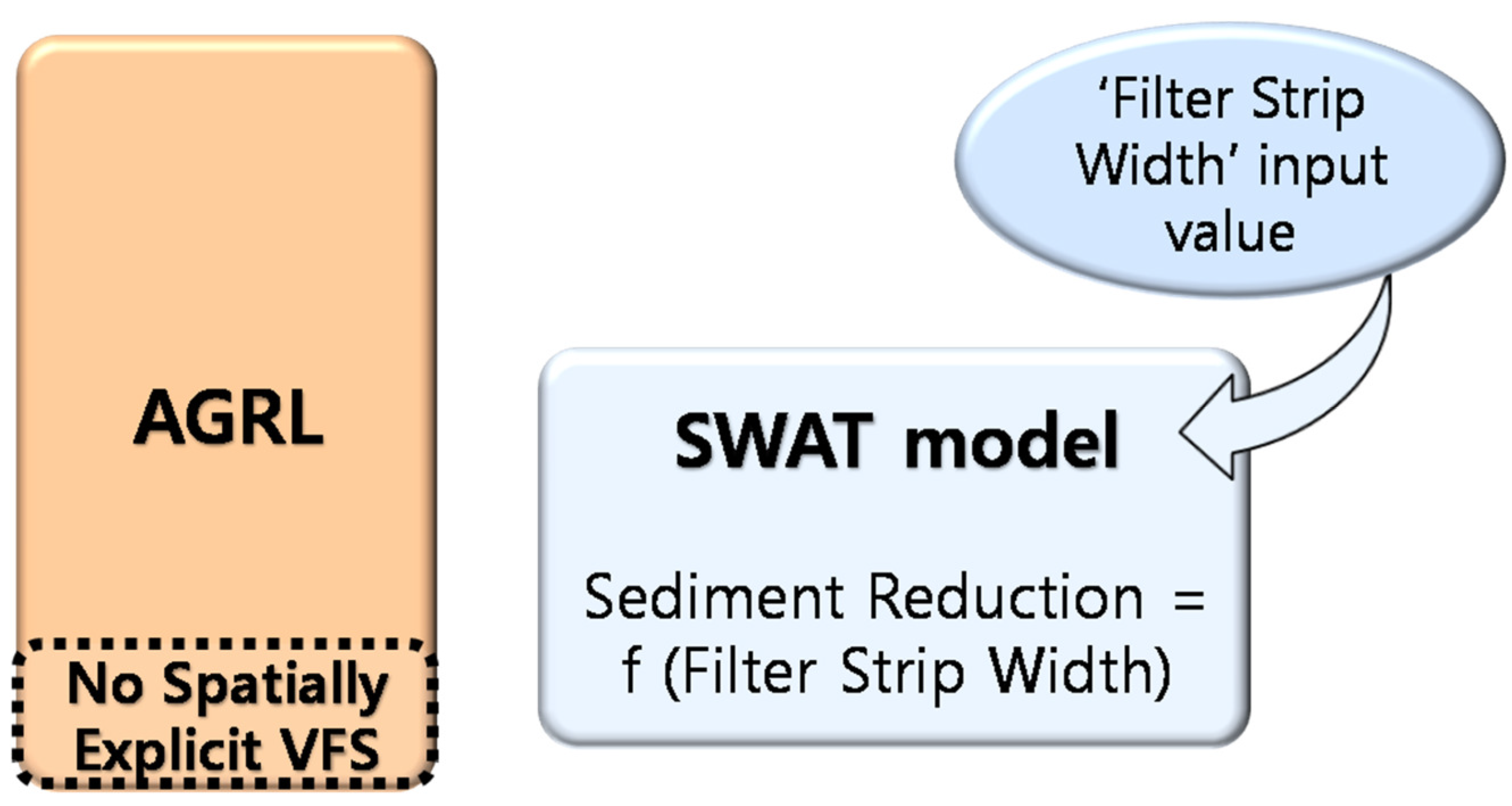
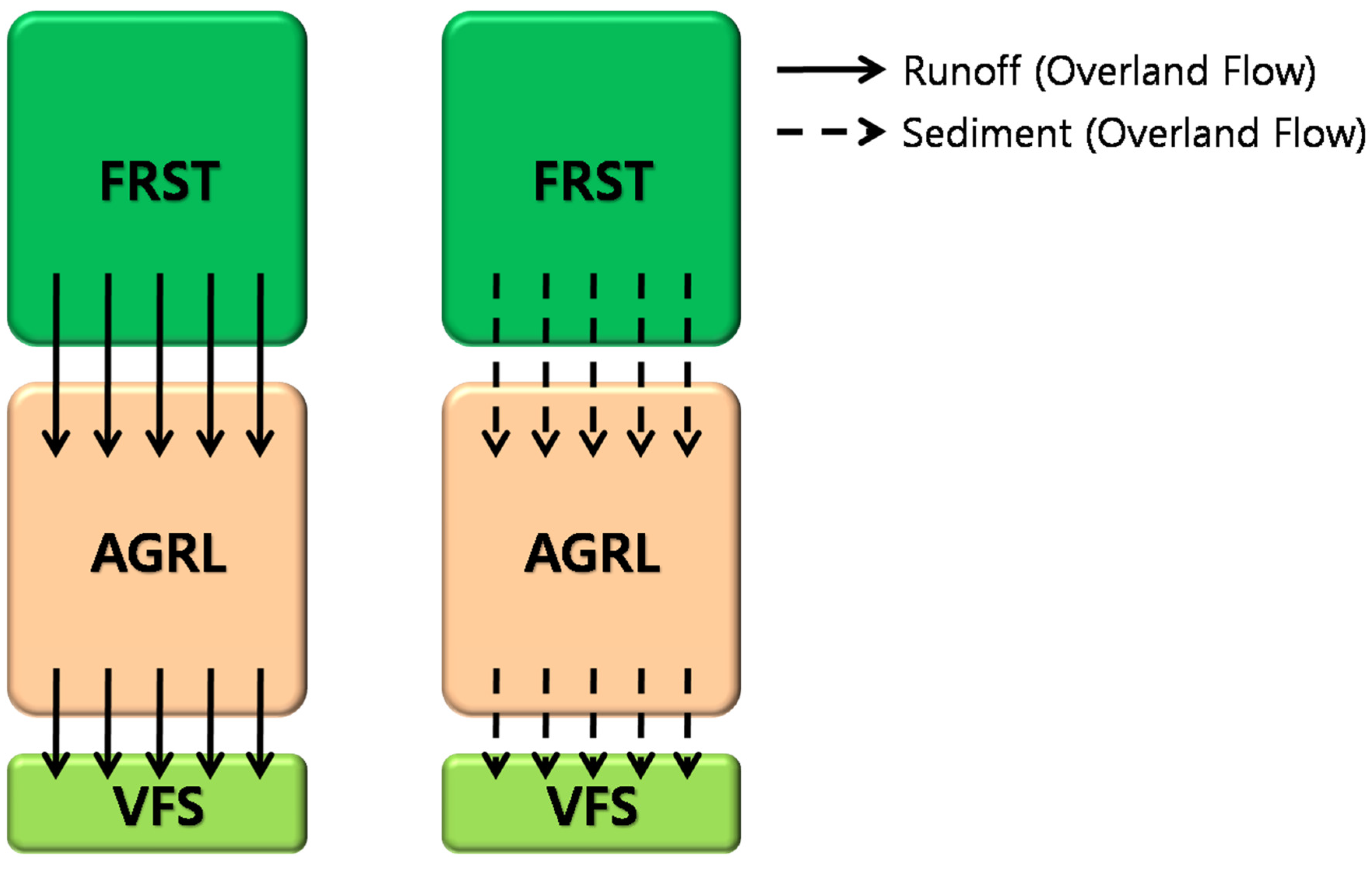
2.1.2. Limitation of SWAT to Estimate Sediment Trapping Efficiency
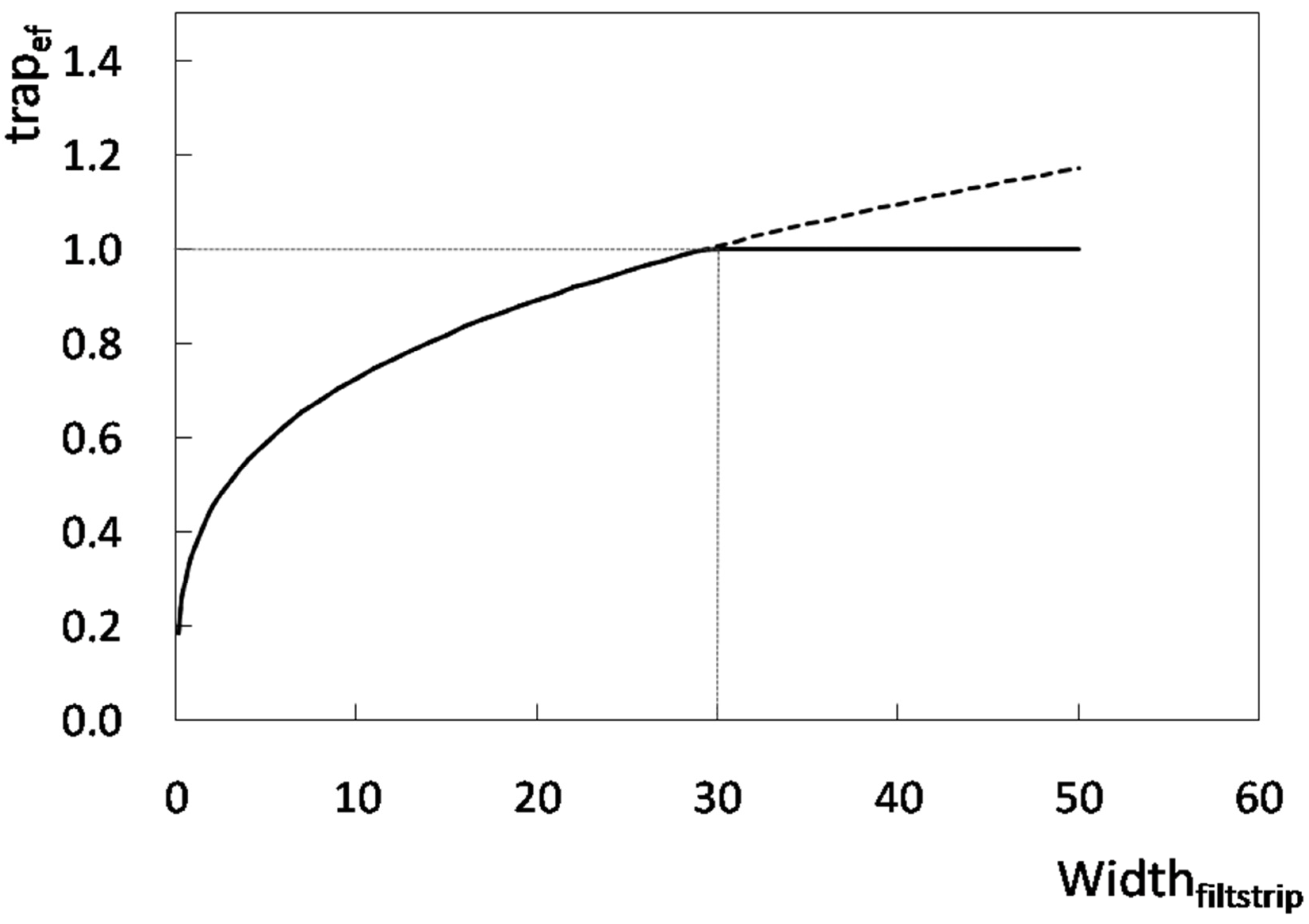
2.2. Enhancement and Application of SWAT for VFS and Diversion Channel Simulation
2.2.1. Enhancement of SWAT for Flow and Sediment Routing in Overland Flow
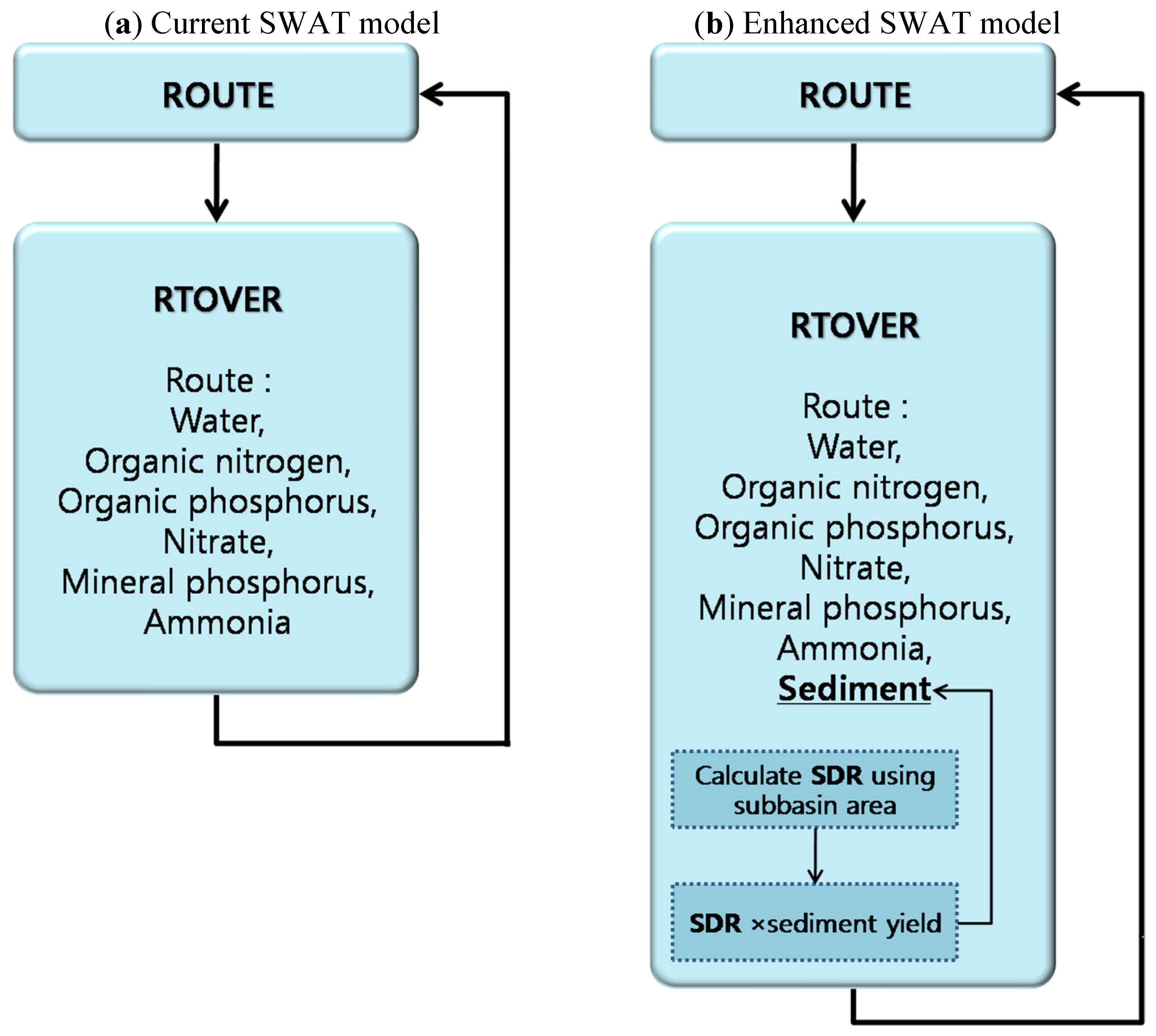
(−0.00007345046 × L3 + 0.001558 × L2 − 0.006376×L −0.001189) × ( ln(V) )3 + (0.0009688469 × L3 − 0.020779 × L2 + 0.095153 × L + 0.019348) × ( ln(V) )2 + (−0.004274 × L3 + 0.092846 × L2 −0.487355 × L − 0.10563) × ( ln(V) ) + (0.006381 × L3 − 0.140713 × L2 + 0.869293 × L + 0.19386)
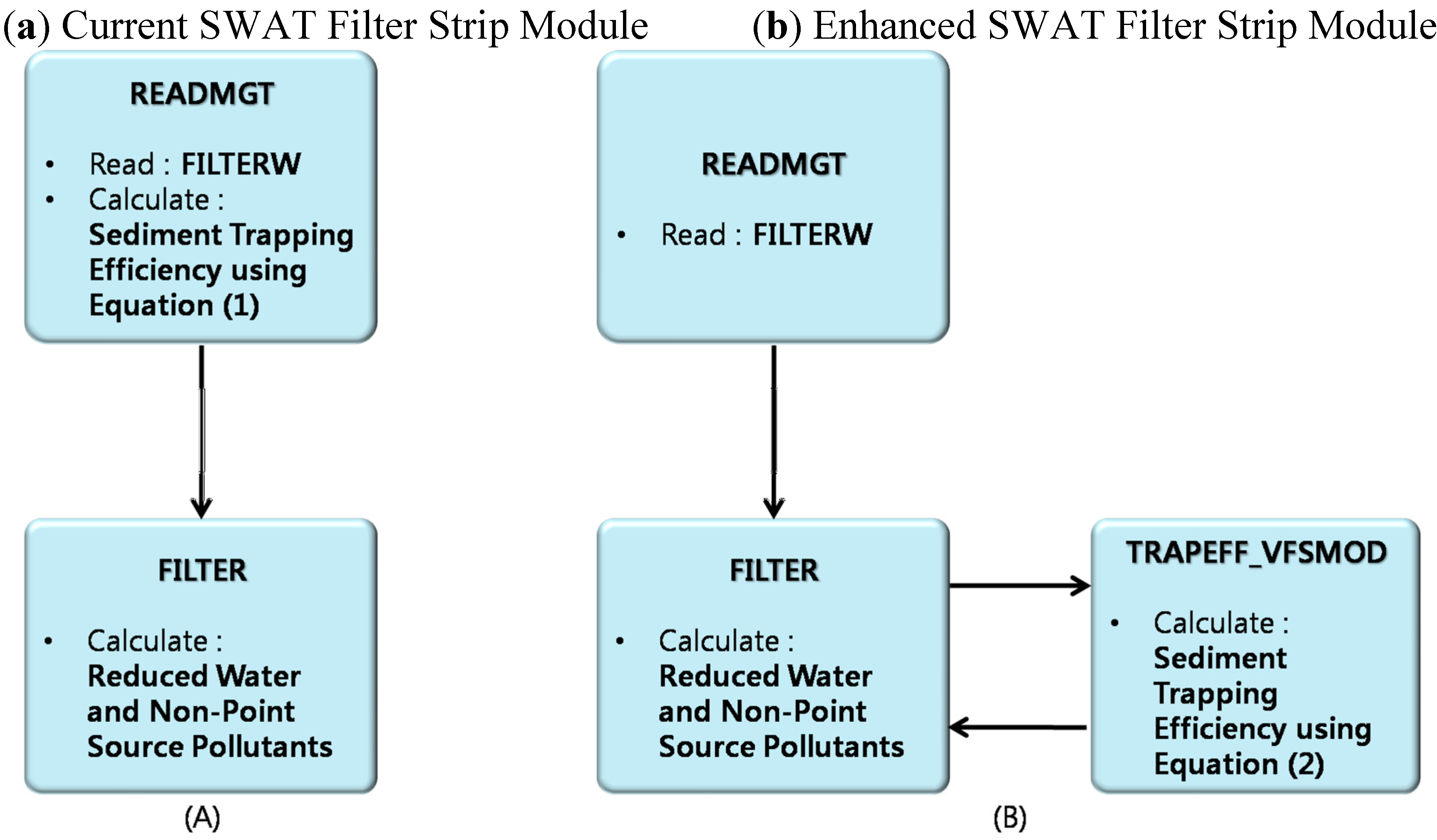
2.2.2. Application of Enhanced SWAT for VFS and Diversion Channel Effects Simulation
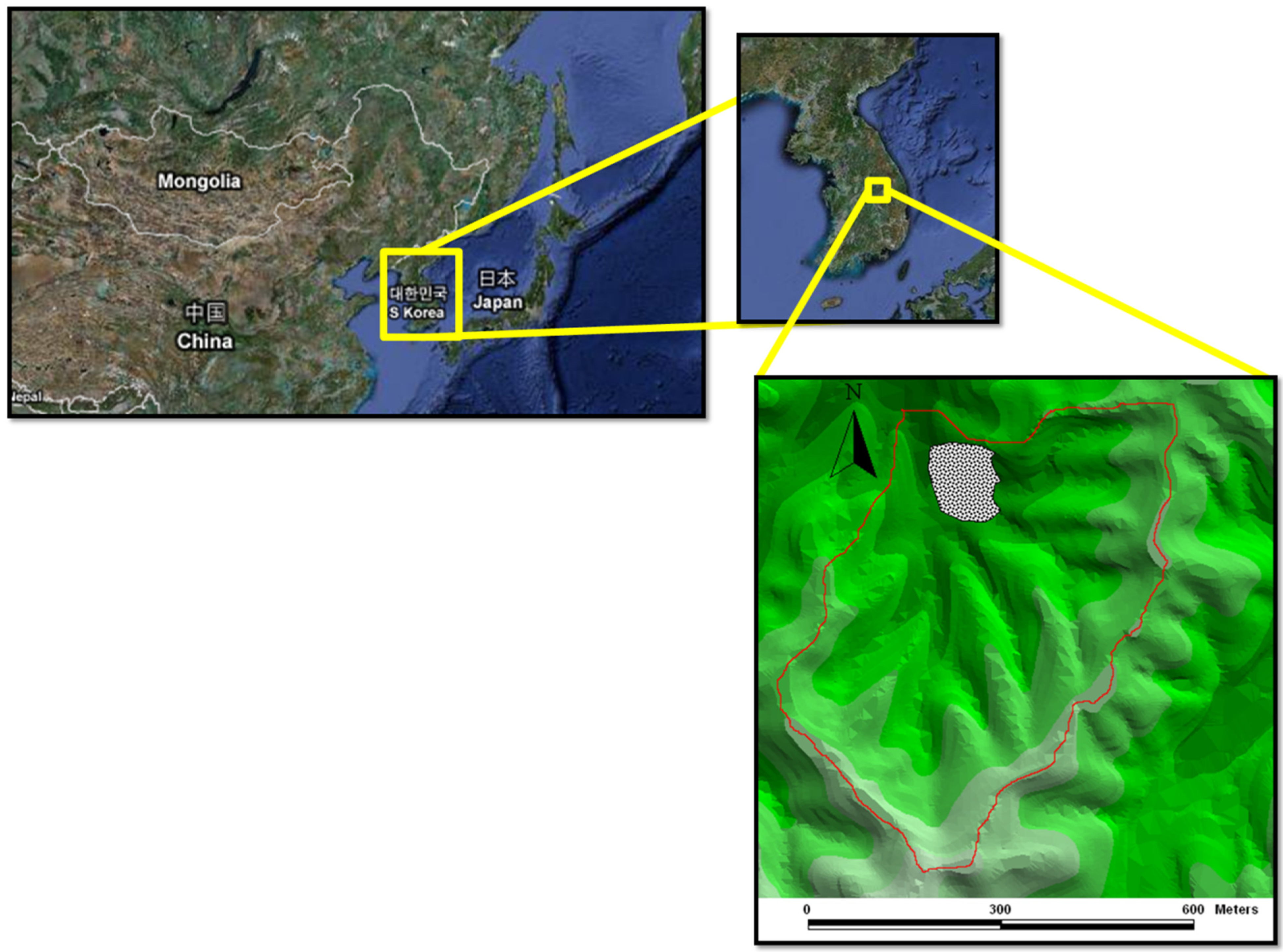
| Diversion Channel | VFS | |
|---|---|---|
| Scenario 1 | Non-Existence | Non-Existence |
| Scenario 2 | Existence | Non-Existence |
| Scenario 3 | Non-Existence | Existence |
| Scenario 4 | Existence | Existence |
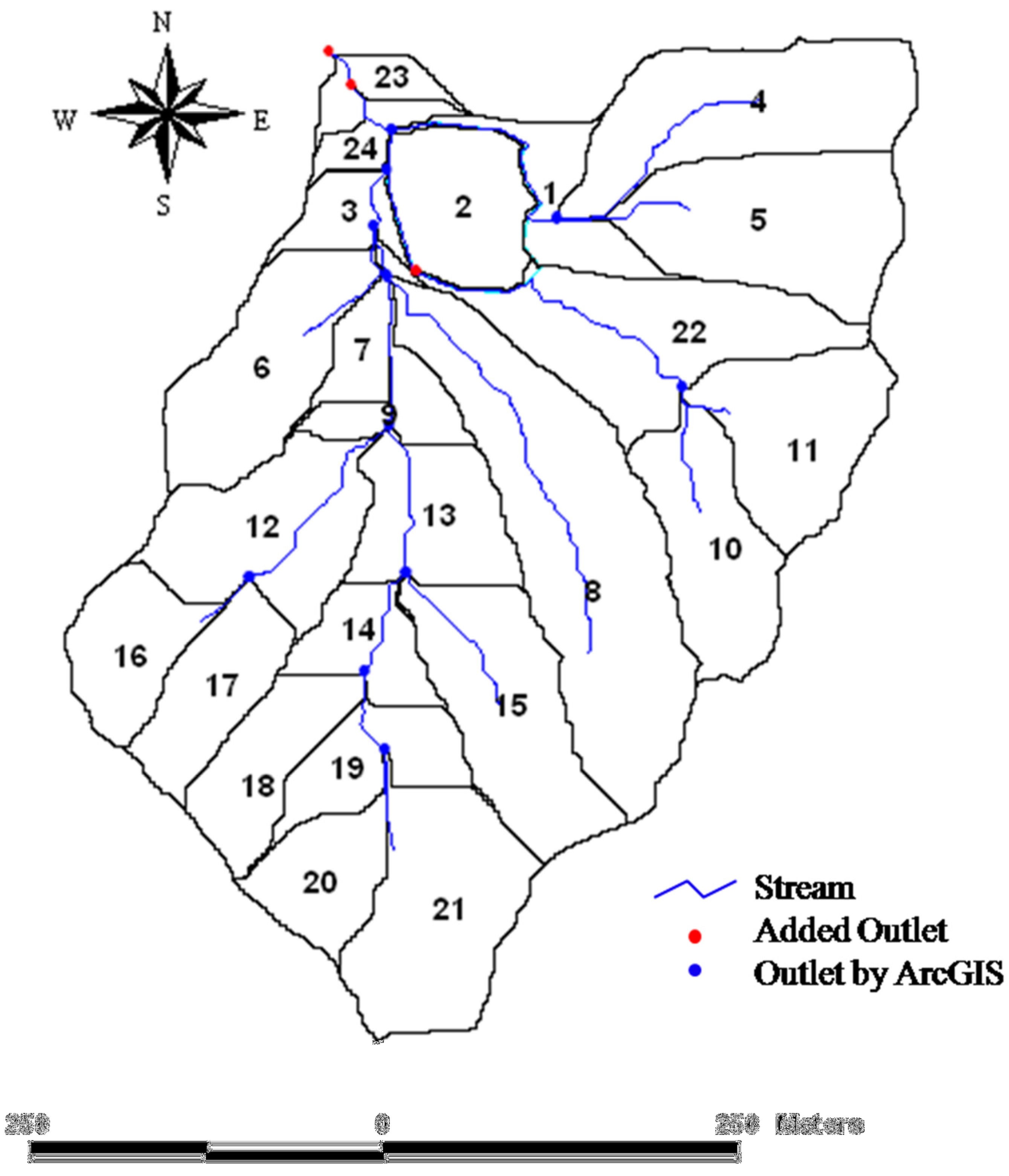
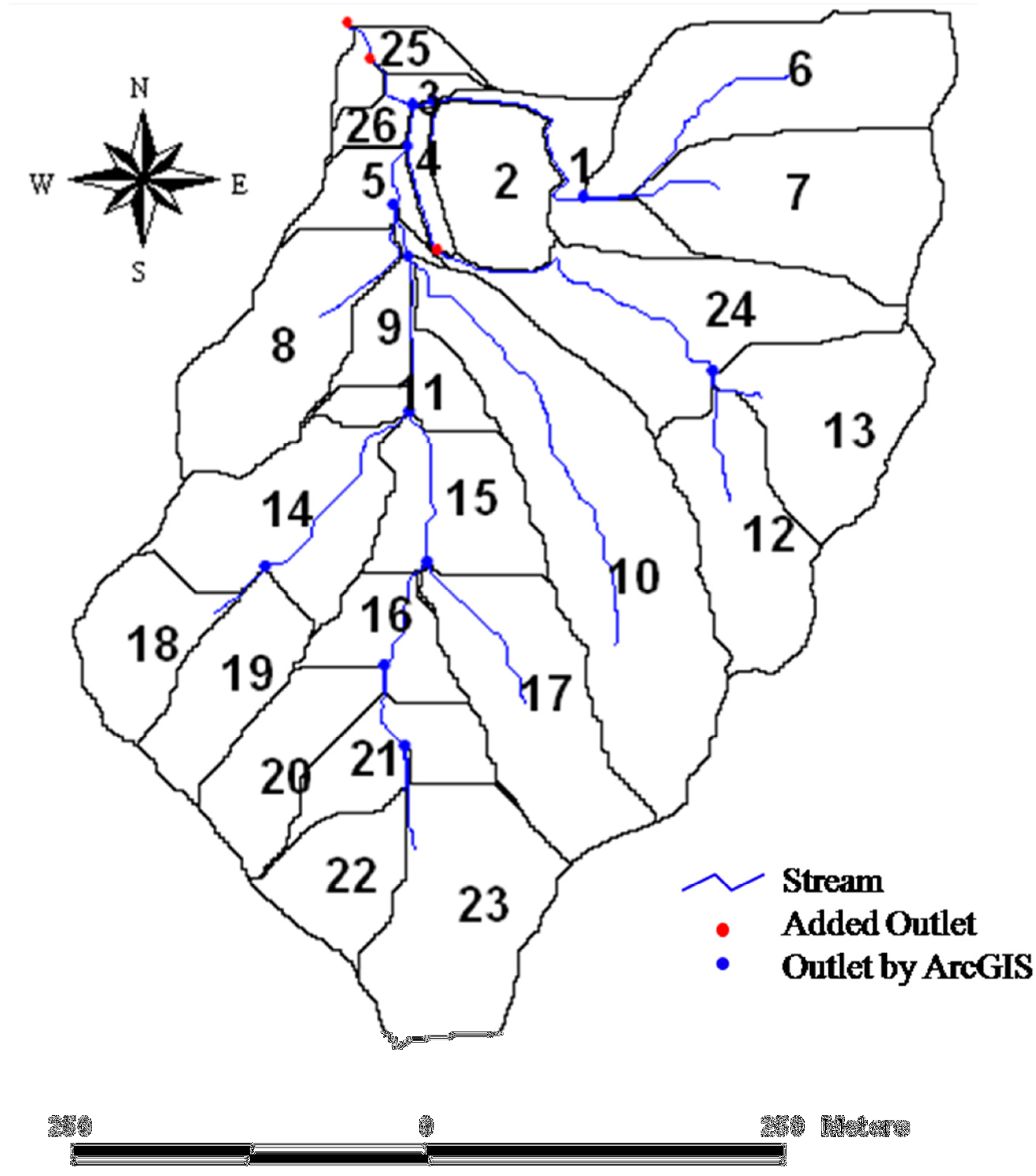
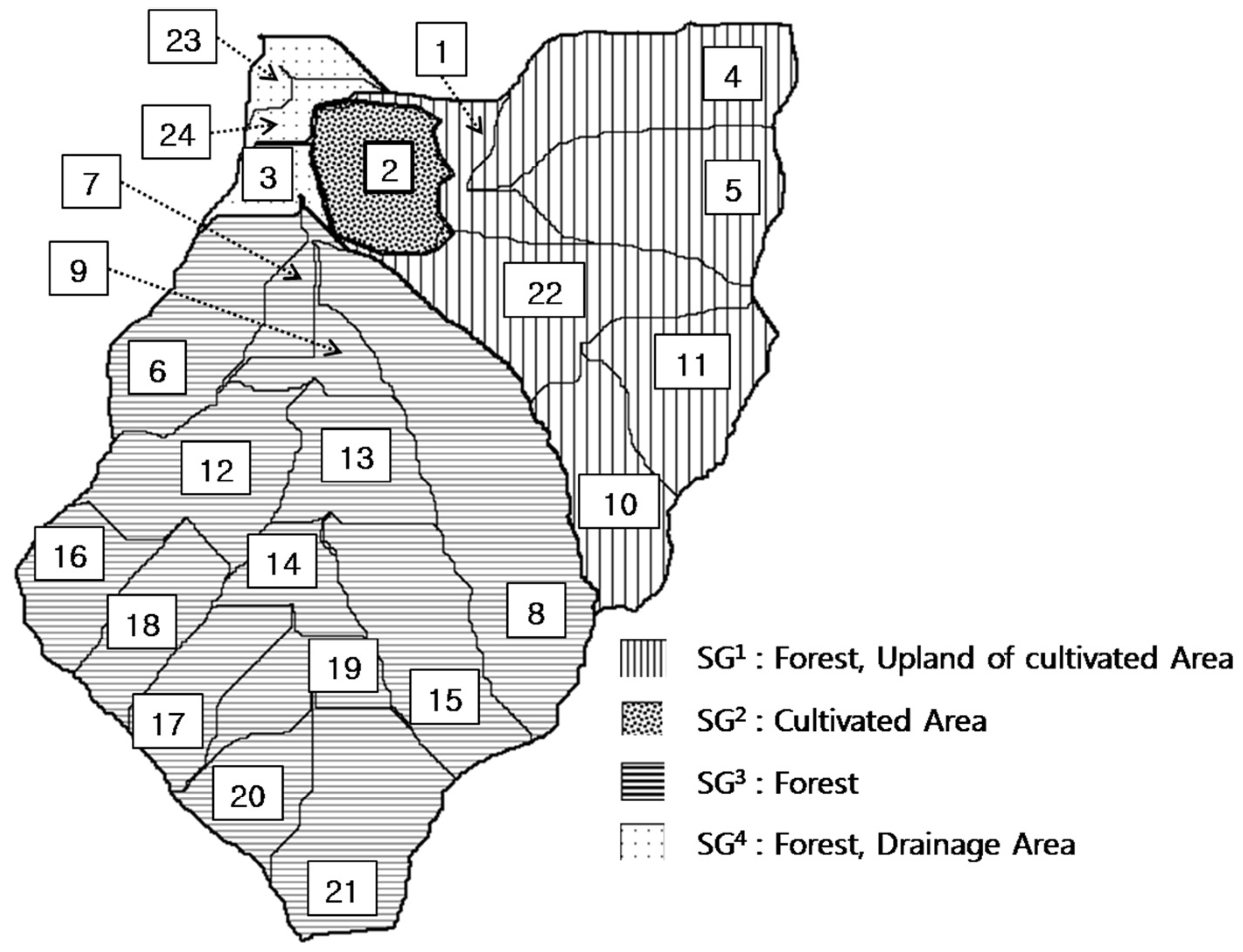
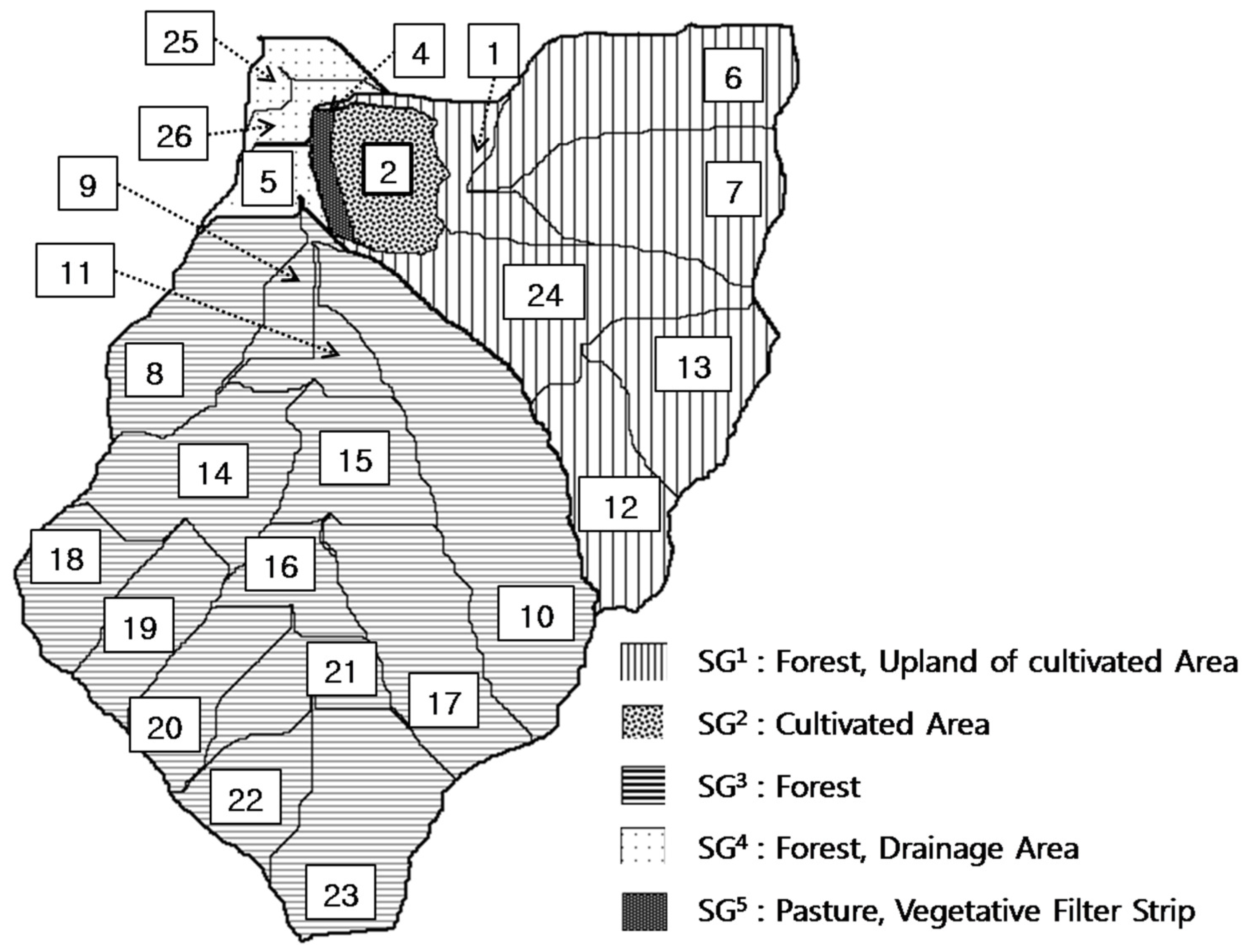
2.2.3. Effect of Diversion Channel on Sediment Reduction
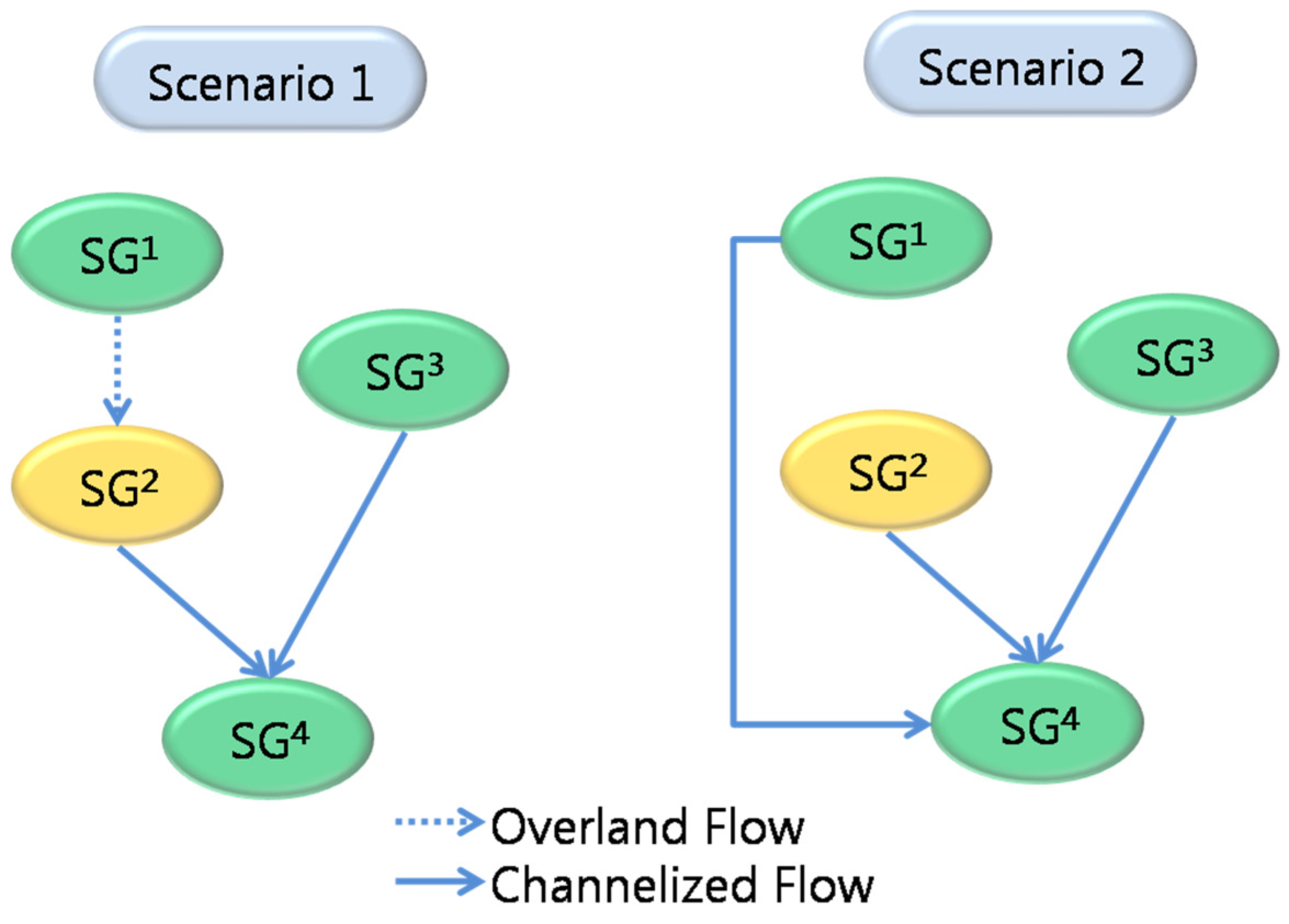
2.2.4. Effect of Diversion Channel and Diversion Channel with VFS on Sediment Reduction
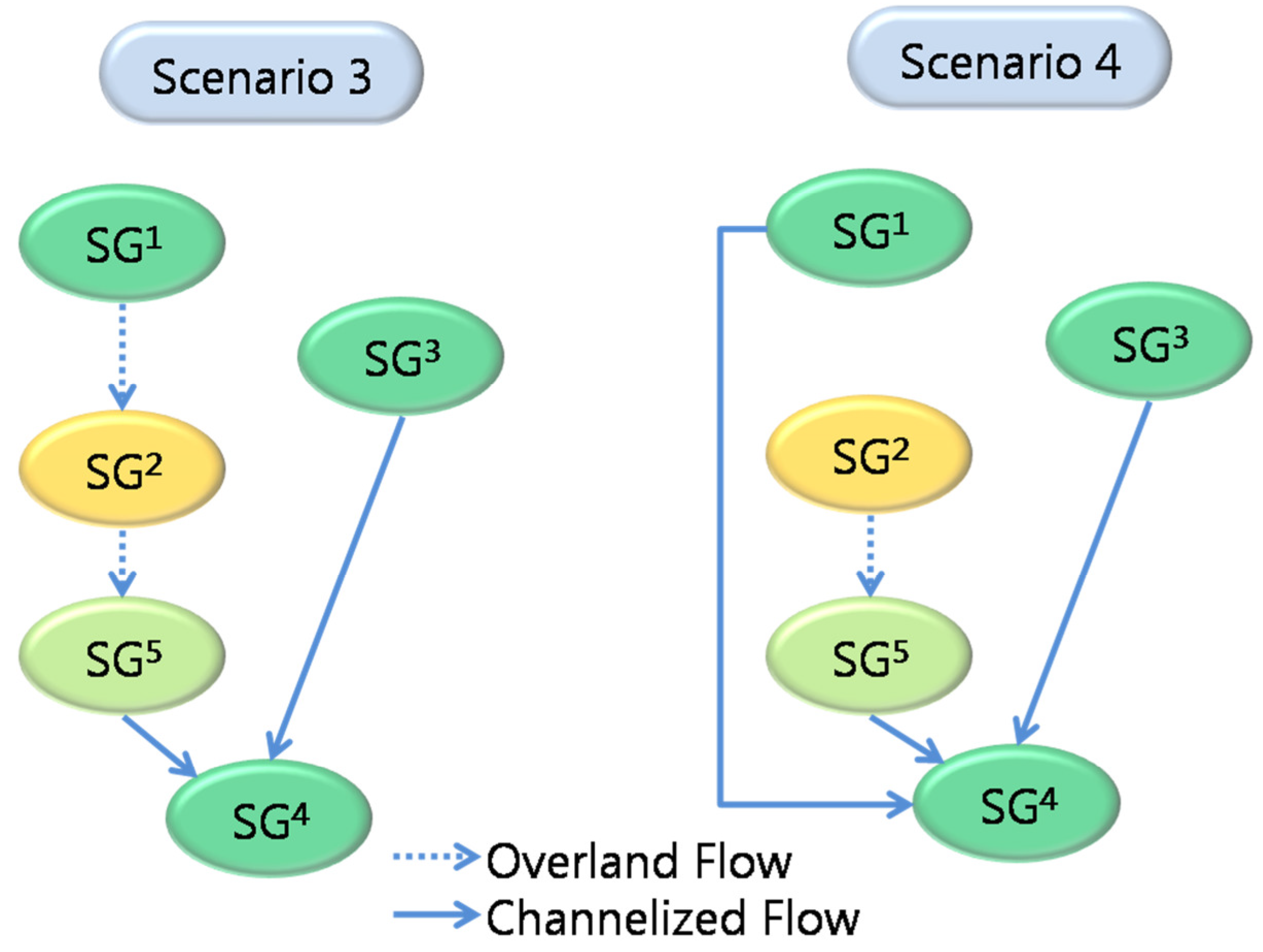
3. Results
3.1. Effects of Diversion Channel on Sediment Reduction (Scenario 1 vs. Scenario 2)
| Flow Rate(m3/s) | Sediment Load(ton/month) | |||||
|---|---|---|---|---|---|---|
| minimum | average | maximum | minimum | average | maximum | |
| Scenario 1 | 0.00003 | 0.01387 | 0.13860 | 0.00013 | 2.687 | 39.850 |
| Scenario 2 | 0.00003 | 0.01390 | 0.13860 | 0.00011 | 1.854 | 33.840 |
| Scenario 3 | 0.00023 | 0.01184 | 0.11750 | 0.00007 | 0.933 | 6.263 |
| Scenario 4 | 0.00005 | 0.01194 | 0.11860 | 0.00011 | 0.860 | 14.650 |
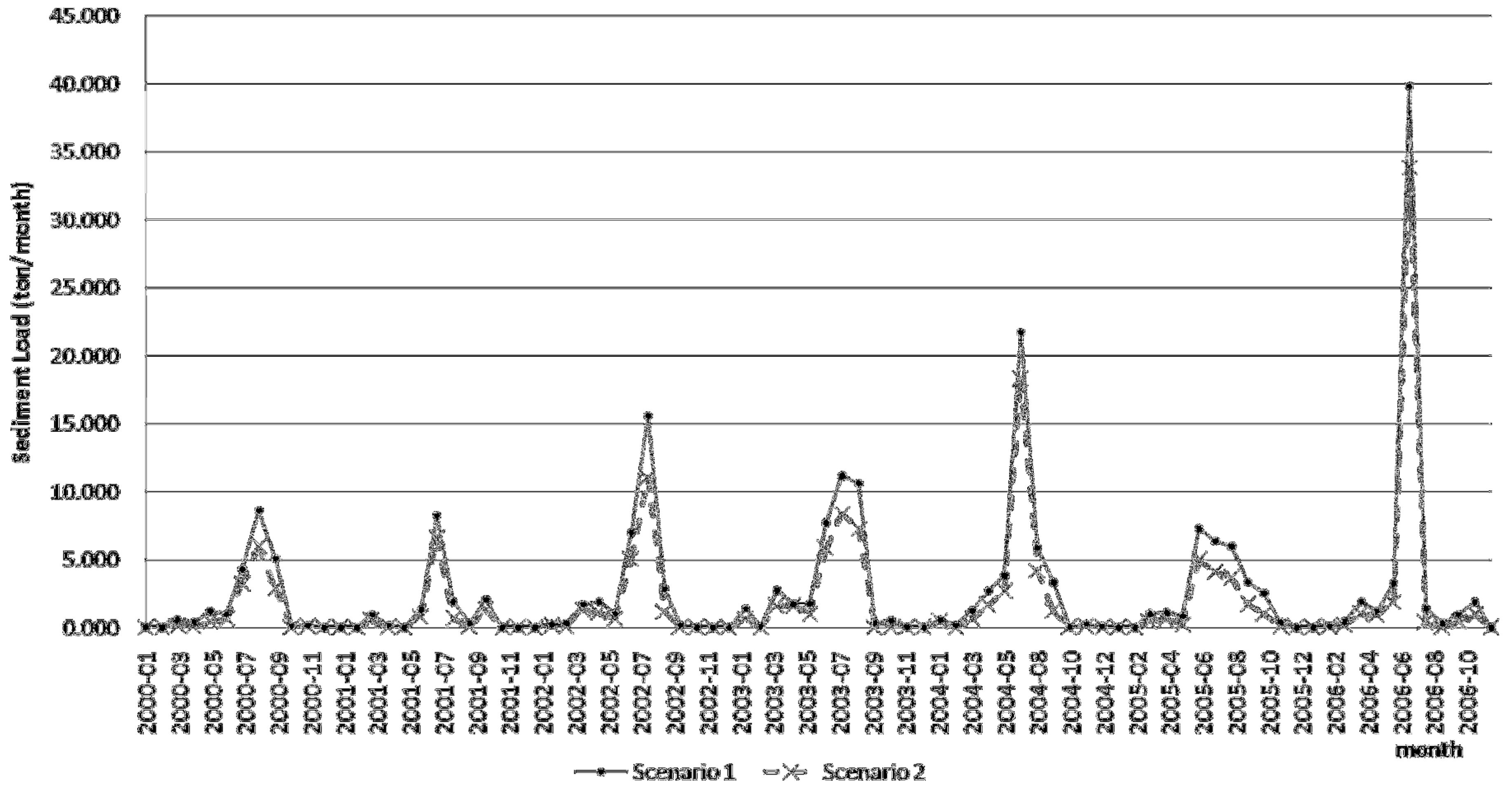
3.2. Effects of VFS on Sediment Reduction (Scenario 1 vs. Scenario 3)
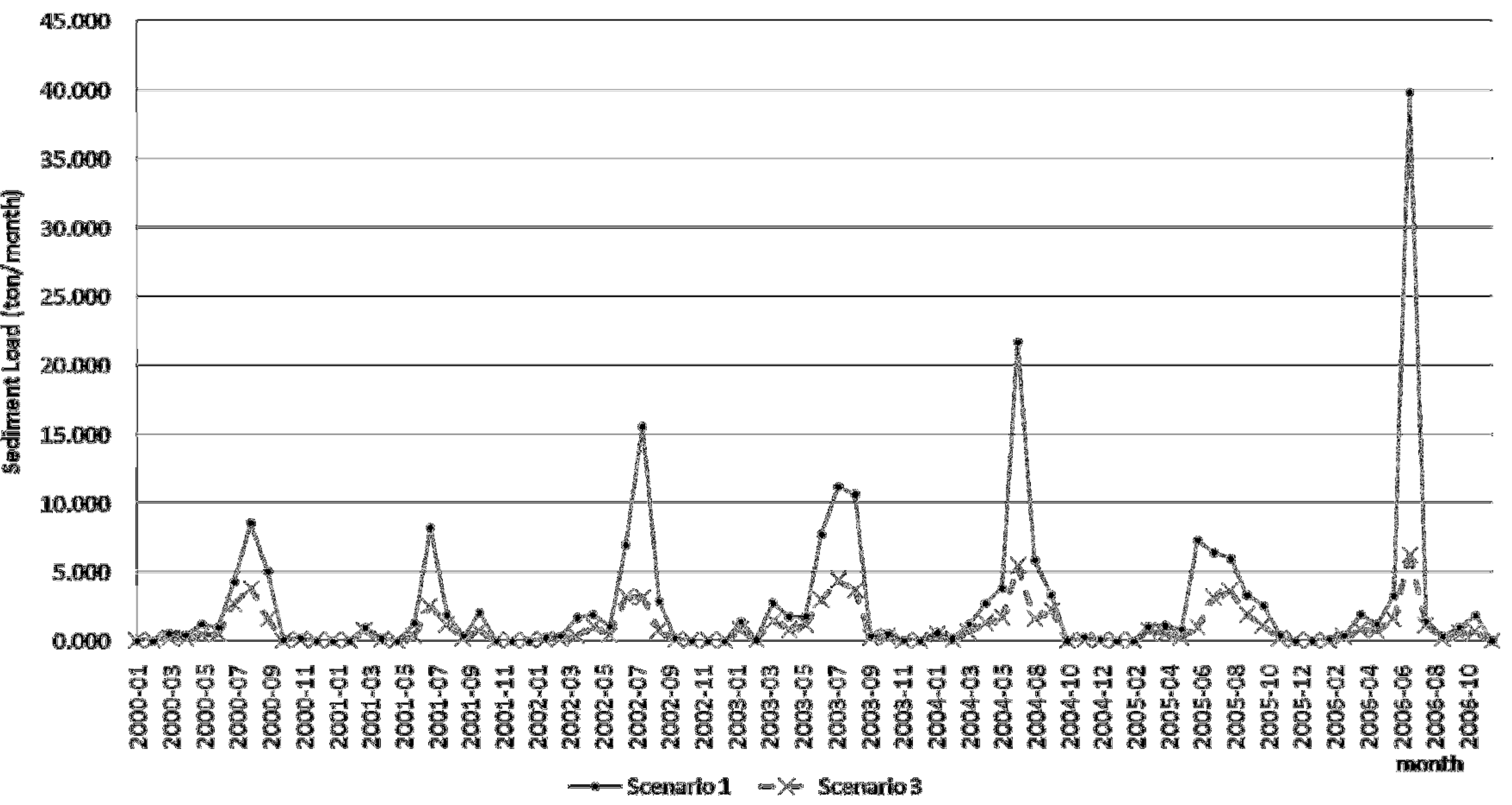
3.3. Effects of VFS with Diversion Channel on Sediment Reduction (Scenario 1 vs. Scenario 4)
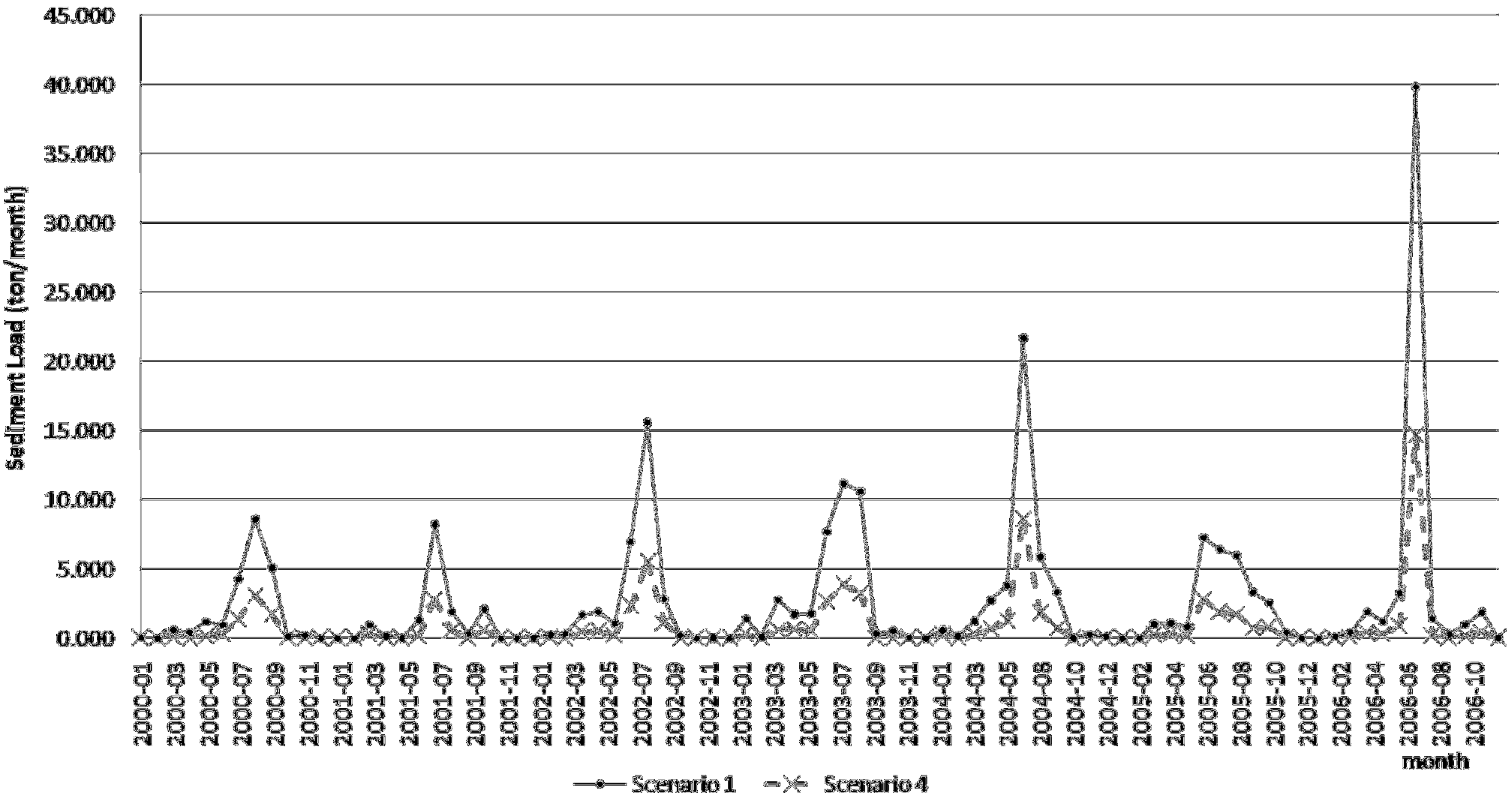
3.4. Effect of Diversion Channel when VFS is Installed at the Edge of the Agricultural Area (Scenario 3 vs. Scenario 4)
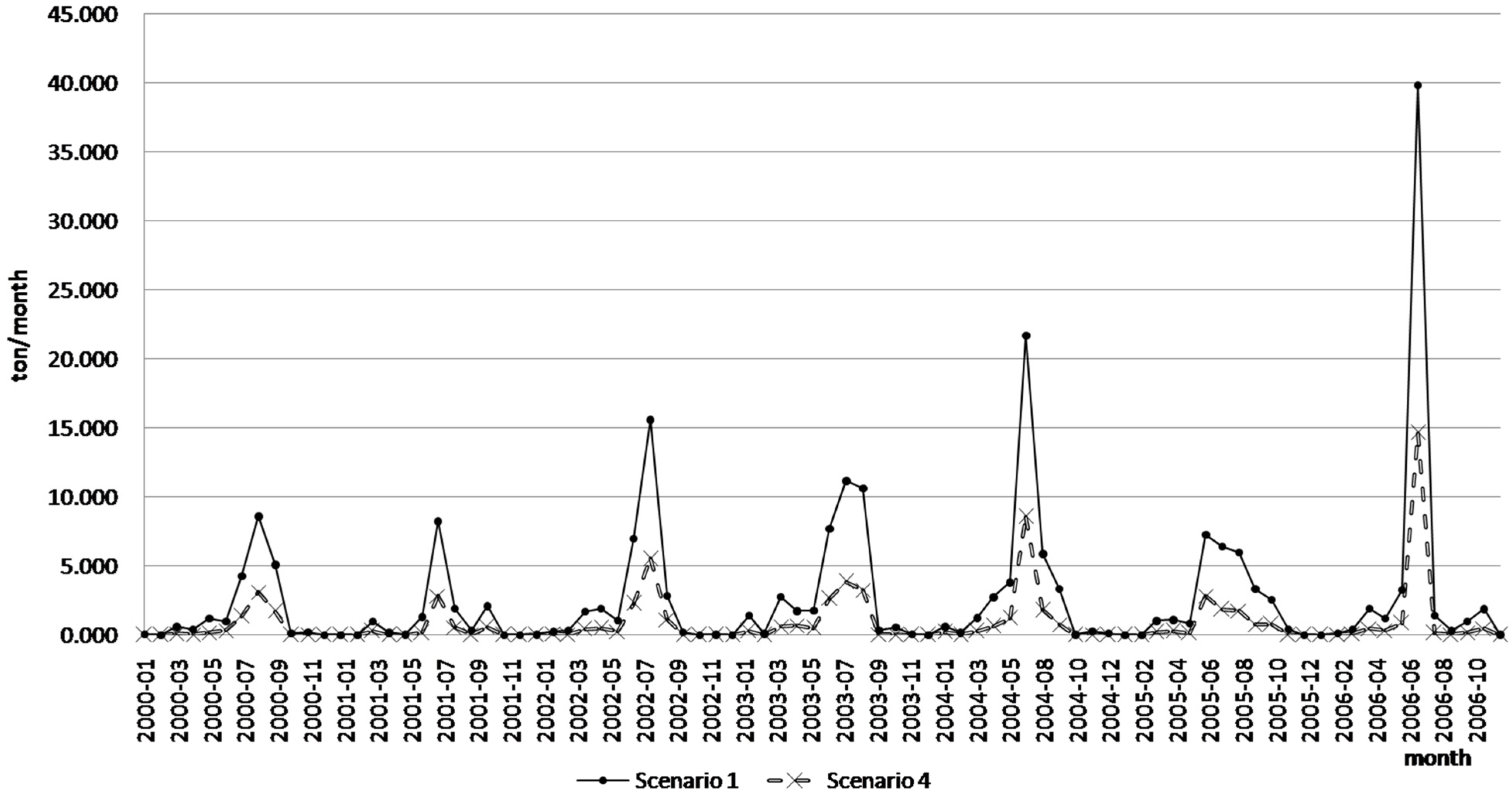
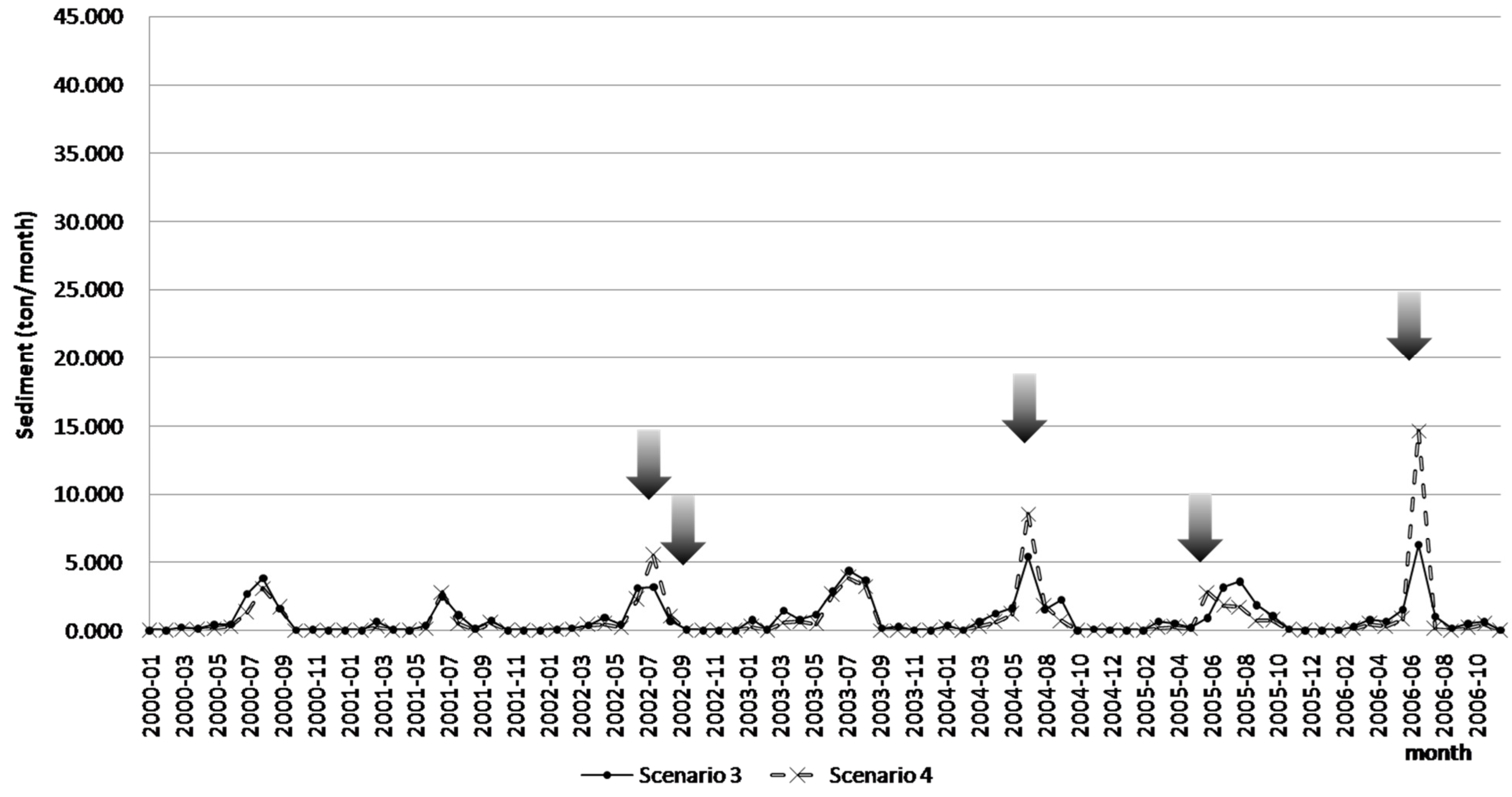
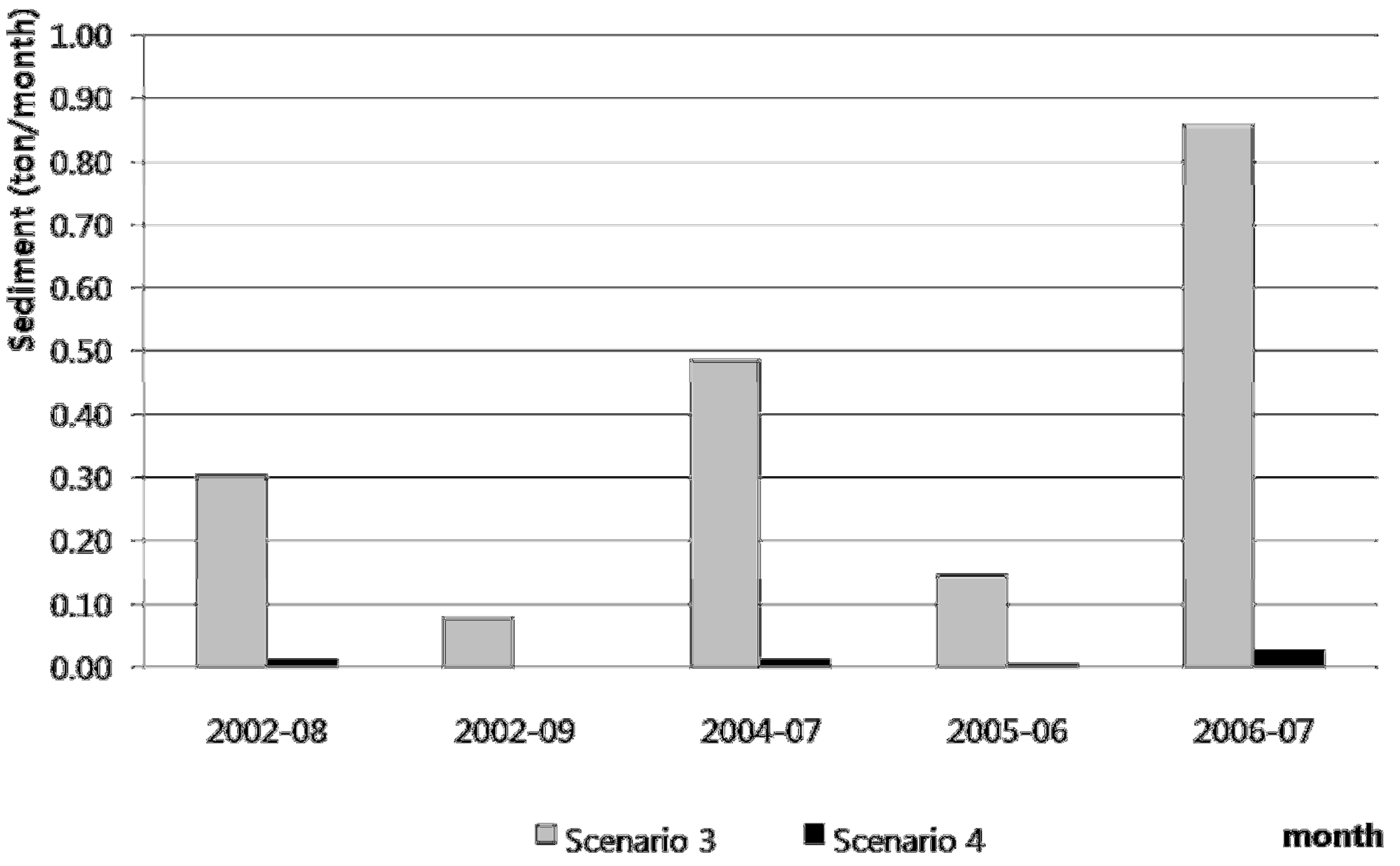
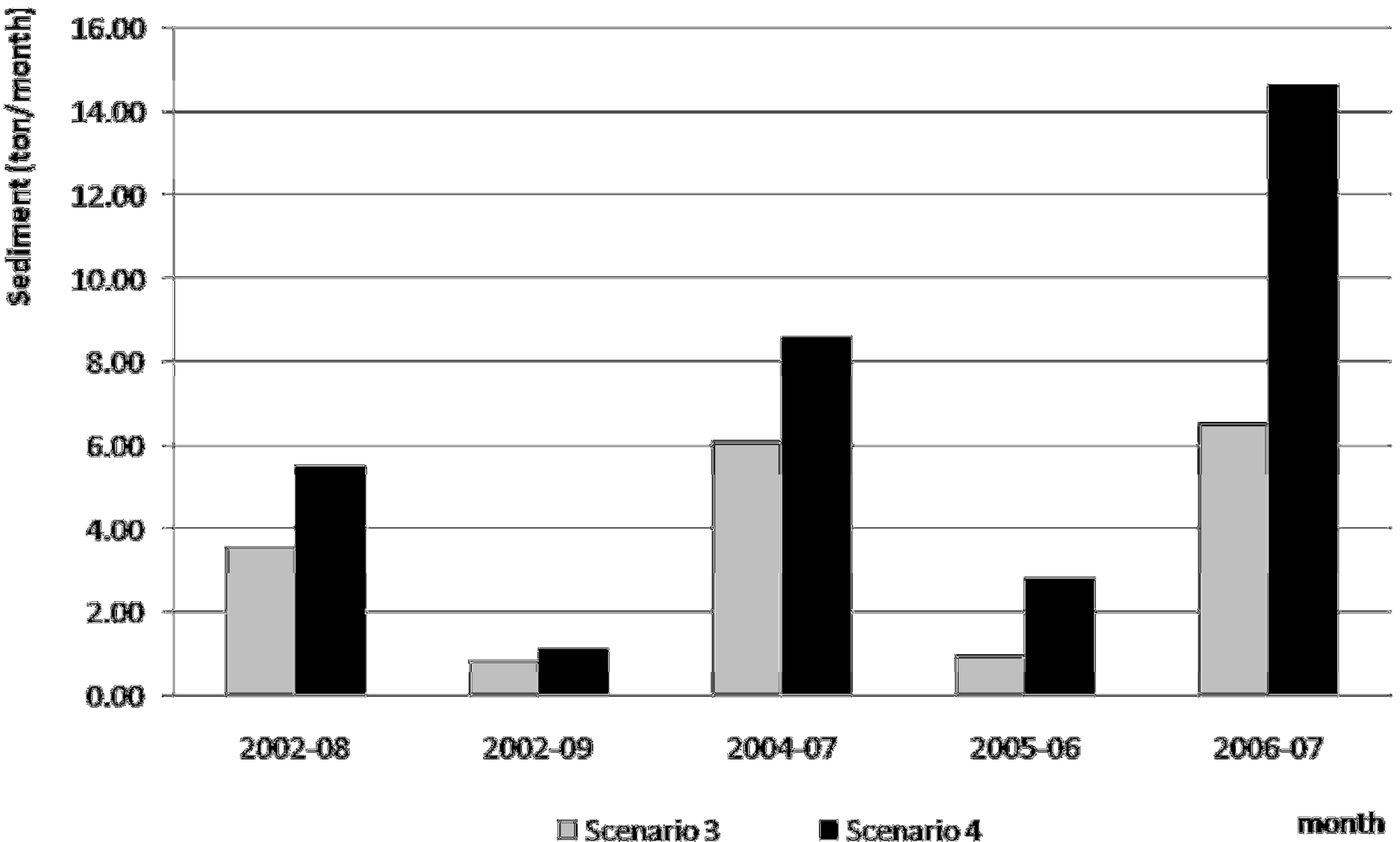
4. Conclusions and Discussion
Acknowledgements
References
- Brown, L.R. Conserving Soils. In State of the World; Brown, L.R., Ed.; Norton: New York, NY, USA, 1984; pp. 53–75. [Google Scholar]
- Lal, R. Soil Erosion by Wind and Water: Problems and Prospects. In Soil Erosion Research Methods, 2nd ed.; St. Lucie Press: Delray Beach, FL, USA, 1994. [Google Scholar]
- Park, S.W.; Mostaghimi, S.; Cooke, R.A.; McClellan, P.W. BMP impacts on watershed runoff, sediment and nutrient yields. Water Resour. Bull 1994, 30, 1011–1023. [Google Scholar] [CrossRef]
- Muñoz−Carpena, R.; Parsons, J.E.; Gilliam, J.W. Modeling hydrology and sediment transport in vegetative filter strips and riparian areas. J. Hydrol. 1999, 214, 111–129. [Google Scholar] [CrossRef]
- Inamdar, S.P.; Mostaghimi, S.; McClellan, P.W.; Brannan, K.M. BMP impacts on sediment and nutrient yields from an agricultural watershed in the coastal plain region. Trans. ASAE 2001, 44, 1191–1200. [Google Scholar] [CrossRef]
- Realizing the Promise of Conservation Buffer Technology; SWCS: Ames, IA, USA, 2001.
- Vennix, S.A.; Northcott, W.J. Prioritizing Vegetative Buffer Strips within Agricultural Watershed. In Proceedings of 2002 ASAE Meeting, St. Joseph, MI, USA, 2002. Paper no. 022135.
- Guber, A.K.; Pachepsky, Y.A.; Sadeghi, A.M. Evaluating uncertainty in E. coli retention in vegetated filter strips in locations selected with SWAT simulations. In Watershed Management to Meet Water Quality Standards and TMDL (Total Maximum Daily Load); ASAE: St. Joseph, MI, USA, 2007; ASABE Publication no. 701P0207. [Google Scholar]
- Arnold, J.G.; Srinivasan, R.; Muttiah, R.S.; Williams, J.R. Large area hydrologic modeling and assessment part I: Model development. J. Am. Water Resour. Assoc. 1998, 34, 73–89. [Google Scholar] [CrossRef]
- Arnold, J.G.; Fohrer, N. SWAT2000: Current capabilities and research opportunities in applied watershed modeling. Hydrol. Process. 2005, 19, 563–572. [Google Scholar] [CrossRef]
- Arabi, M.; Govindaraju, R.S.; Hantush, M.M.; Engel, B.A. Role of watershed subdivision on modeling the effectiveness of best management practices with SWAT. J. Am. Water Resour. Assoc. 2006, 42, 513–528. [Google Scholar] [CrossRef]
- Behera, S.; Panda, R.K. Evaluation of management alternatives for an agricultural watershed in a sub-humid subtropical region using a physical process model. Agric. Ecosys. Environ. 2006, 113, 62–72. [Google Scholar] [CrossRef]
- Bracmort, K.S.; Arabi, M.; Frankenberger, J.R.; Engel, B.A.; Arnold, J.G. Modeling long-term water quality impact of structural BMPs. Trans. ASABE 2006, 49, 367–374. [Google Scholar] [CrossRef]
- Jha, M.; Gassman, P.W.; Arnold, J.G. Water quality modeling for the Raccoon River watershed using SWAT2000. Trans. ASABE 2007, 50, 479–493. [Google Scholar] [CrossRef]
- Mishra, A.; Froebrich, J.; Gassman, P.W. Evaluation of the SWAT model for assessing sediment control structures in a small watershed in India. Trans. ASABE 2007, 50, 469–478. [Google Scholar] [CrossRef]
- Gassman, P.W.; Reyes, M.R.; Green, C.H.; Arnold, J.G. The soil and water assessment tool: Historical development, applications, and future research directions. Trans. ASABE 2007, 50, 1211–1250. [Google Scholar] [CrossRef]
- Luo, Y.; Chansheng, H.; Sophocleous, M.; Yin, Z.; Hongrui, R.; Ouyang, Z. Assessment of crop growth and soil water modules in SWAT2000 using extensive field experiment data in an irrigation district of the Yellow River Basin. J. Hydrol. 2008, 352, 139–156. [Google Scholar] [CrossRef]
- Parajuli, P.B.; Mankin, K.R.; Barnes, P.L. Applicability of targeting vegetative filter strip to abate fecal bacteria and sediment yield using SWAT. Agric. Water Manag. 2008, 1189–1200. [Google Scholar]
- Neitsch, S.L.; Arnold, J.G.; Kiniry, J.R.; Williams, J.R. Soil and Water Assessment Tool User’s Manual Version 2005; SWAT: Temple, TX, USA, 2000. [Google Scholar]
- Fox, G.A.; Muñoz-Carpena, R.; Sabbagh, G.J. Influence of flow concentration on parameter importance and prediction uncertainty of pesticide trapping by vegetative filter strips. J. Hydrol. 2010, 384, 164–173. [Google Scholar] [CrossRef]
- Muñoz-Carpena, R.; Zajac, Z.; Kuo, Y.M. Global sensitivity and uncertainty analyses of the Water Quality Model VFSMOD-W. Trans. ASABE 2007, 50, 1719–1732. [Google Scholar] [CrossRef]
- Muñoz-Carpena, R.; Fox, G.A.; Sabbagh, G.J. Parameter importance and uncertainty in predicting runoff pesticide reduction with filter strips. J. Environ. Qual. 2010, 39, 630–641. [Google Scholar] [CrossRef] [PubMed]
- Park, Y.S.; Kim, J.; Kim, N.; Park, J.; Jang, W.S.; Choi, J.; Lim, K.J. Improvement of sediment trapping efficiency module in SWAT using VFSMOD-w Model. J. Korean Soc. Water Qual. 2008, 24, 473–479. [Google Scholar]
- Otto, S.; Vianello, M.; Infantino, A.; Zanin, G.; Di Guardo, A. Effect of a full-grown vegetative filter strip on herbicide runoff: Maintaining of filter capacity over time. Chemosphere 2008, 71, 74–82. [Google Scholar] [CrossRef] [PubMed]
- White, M.J.; Arnold, J.G. Development of a simplistic vegetative filter strip model for sediment and nutrient retention at the field scale. Hydrol. Process. 2009, 23, 1602–1616. [Google Scholar] [CrossRef]
- Vanoni, V.A. Sedimentation Engineering (Manual and Report on Engineering Practice Ser., No. 54); American Society of Civil Engineers: New York, NY, USA, 1975. [Google Scholar]
- Muñoz-Carpena, R.; Miller, C.T.; Parsons, J.E. A quadratic Petrov–Galerkin solution for kinematic wave overland flow. Water Resour. Res. 1993, 29, 2615–2627. [Google Scholar] [CrossRef]
- Muñoz-Carpena, R.; Parsons, J.E.; Gilliam, J.W. Numerical approach to the overland flow process in vegetative fi lter strips. Trans. ASAE 1993, 36, 761–770. [Google Scholar] [CrossRef]
- Muñoz-Carpena, R.; Parsons, J.E. A design procedure for vegetative filter strips using VFSMOD-W. Trans. ASAE 2004, 47, 1933–1941. [Google Scholar] [CrossRef]
- Muñoz-Carpena, R.; Parsons, J.E. VFSMOD-W: A vegetative filter strip hydrology and sediment transport modeling system v5.x (draft). Department of Agricultural & Biological Engineering, University of Florida; Gainesville: FL, USA, 2008. Available online: http://carpena.ifas.ufl.edu/vfsmod (accessed on 12 January 2010).
© 2011 by the authors; licensee MDPI, Basel, Switzerland. This article is an open access article distributed under the terms and conditions of the Creative Commons Attribution license (http://creativecommons.org/licenses/by/3.0/).
Share and Cite
Park, Y.S.; Park, J.H.; Jang, W.S.; Ryu, J.C.; Kang, H.; Choi, J.; Lim, K.J. Hydrologic Response Unit Routing in SWAT to Simulate Effects of Vegetated Filter Strip for South-Korean Conditions Based on VFSMOD. Water 2011, 3, 819-842. https://doi.org/10.3390/w3030819
Park YS, Park JH, Jang WS, Ryu JC, Kang H, Choi J, Lim KJ. Hydrologic Response Unit Routing in SWAT to Simulate Effects of Vegetated Filter Strip for South-Korean Conditions Based on VFSMOD. Water. 2011; 3(3):819-842. https://doi.org/10.3390/w3030819
Chicago/Turabian StylePark, Youn Shik, Jeong Hee Park, Won Seok Jang, Ji Chul Ryu, Hyunwoo Kang, Joongdae Choi, and Kyoung Jae Lim. 2011. "Hydrologic Response Unit Routing in SWAT to Simulate Effects of Vegetated Filter Strip for South-Korean Conditions Based on VFSMOD" Water 3, no. 3: 819-842. https://doi.org/10.3390/w3030819
APA StylePark, Y. S., Park, J. H., Jang, W. S., Ryu, J. C., Kang, H., Choi, J., & Lim, K. J. (2011). Hydrologic Response Unit Routing in SWAT to Simulate Effects of Vegetated Filter Strip for South-Korean Conditions Based on VFSMOD. Water, 3(3), 819-842. https://doi.org/10.3390/w3030819






